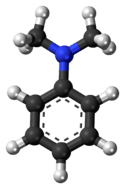Dimethylaniline
| |||
| Names | |||
|---|---|---|---|
| Preferred IUPAC name
N,N-Dimethylaniline | |||
| Other names
DMA Dimethylaminobenzene N,N-Dimethylbenzeneamine N,N-Dimethylphenylamine | |||
| Identifiers | |||
| 121-69-7 | |||
| 3D model (Jmol) | Interactive image | ||
| ChEBI | CHEBI:16269 | ||
| ChEMBL | ChEMBL371654 | ||
| ChemSpider | 924 | ||
| ECHA InfoCard | 100.004.085 | ||
| KEGG | C02846 | ||
| PubChem | 949 | ||
| |||
| |||
| Properties | |||
| C8H11N | |||
| Molar mass | 121.18 g·mol−1 | ||
| Appearance | Colorless liquid | ||
| Odor | amine-like | ||
| Density | 0.956 g/mL | ||
| Melting point | 2 °C (36 °F; 275 K) | ||
| Boiling point | 194 °C (381 °F; 467 K) | ||
| 2% (20°C)[1] | |||
| Vapor pressure | 1 mmHg (20°C)[1] | ||
| Hazards | |||
| Safety data sheet | External MSDS | ||
| Flash point | 63 °C (145 °F; 336 K) | ||
| Lethal dose or concentration (LD, LC): | |||
| LD50 (median dose) |
1410 mg/kg (rat, oral)[2] | ||
| LCLo (lowest published) |
50 ppm (rat, 4 hr)[2] | ||
| US health exposure limits (NIOSH): | |||
| PEL (Permissible) |
TWA 5 ppm (25 mg/m3) [skin][1] | ||
| REL (Recommended) |
TWA 5 ppm (25 mg/m3) ST 10 ppm (50 mg/m3) [skin][1] | ||
| IDLH (Immediate danger) |
100 ppm[1] | ||
| Except where otherwise noted, data are given for materials in their standard state (at 25 °C [77 °F], 100 kPa). | |||
| | |||
| Infobox references | |||
N,N-Dimethylaniline (DMA) is an organic chemical compound, a substituted derivative of aniline. It consists of a tertiary amine, featuring dimethylamino group attached to a phenyl group. This oily liquid is colourless when pure, but commercial samples are often yellow. It is an important precursor to dyes such as crystal violet.
Preparation and reactions
DMA was first reported in 1850 by the German chemist A. W. Hofmann, who prepared it by heating aniline and iodomethane:[3][4]
- C6H5NH2 + 2 CH3I → C6H5N(CH3)2 + 2 HI
DMA is produced industrially by alkylation of aniline with methanol in the presence of an acid catalyst:[5]
- C6H5NH2 + 2 CH3OH → C6H5N(CH3)2 + 2 H2O
Similarly, it is also prepared using dimethyl ether as the methylating agent.
Dimethylaniline undergoes many of the reactions expected for an aniline, being weakly basic and reactive toward electrophiles. For example, it is nitrated to produce tetryl, a derivative with four nitro groups which was once used as explosive. It is lithiated with butyllithium. Methylating agents attack the amine to give the quaternary ammonium salt:[6]
- C6H5N(CH3)2 + (CH3O)2SO2 → C6H5N(CH3)3CH3OSO3
Applications
DMA is a key precursor to commercially important triarylmethane dyes such as malachite green and crystal violet.[7] DMA serves as a promoter in the curing of polyester and vinyl ester resins.[8] DMA is also used as a precursor to other organic compounds. A study of the in vitro metabolism of N,N-dimethylaniline using guinea pig and rabbit preparations and GLC techniques has confirmed N-demethylation and N-oxidation as metabolic pathways, and has also established ring hydroxylation as a metabolic route.[9] Its derivative 2,4-dimethylaniline is a recalcitrant degradant of the pesticide amitraz and is also an industrial pollutant which is genotoxic, teratogenic and carcinogenic.[10]
References
- 1 2 3 4 5 "NIOSH Pocket Guide to Chemical Hazards #0223". National Institute for Occupational Safety and Health (NIOSH).
- 1 2 "N,N-Dimethylaniline". Immediately Dangerous to Life and Health. National Institute for Occupational Safety and Health (NIOSH).
- ↑ Watts, Henry, A Dictionary of Chemistry and the Allied Branches of Other Sciences, Part 2, (London, England: Longmans, Green, and Co., 1881), Methylanilines, p. 1306
- ↑ In 1850, August Hofmann announced his synthesis of methylaniline:
- Hofmann, A. W. (1850) "Researches regarding the molecular constitution of the volatile organic bases," Philosophical Transactions of the Royal Society of London, 140 : 93–131 ; see especially pp. 113-114.
- Kern, A. (1877) "Ueber die Darstellung von Monomethylanilin" (On the preparation of monomethylaniline), Berichte der deutschen chemischen Gesellschaft, 10 : 195–199.
- Hofmann, A. W. (1877) "Versuche über die Einwirkung des Chlor-, Brom- und Jodmethyls auf Anilin" (Experiments on the reaction of methyl chloride, bromide and iodide with aniline), Berichte der deutschen chemischen Gesellschaft, 10 : 591–601.
- ↑ Kahl, Thomas et al. (2007) "Aniline" in Ullmann's Encyclopedia of Industrial Chemistry. John Wiley & Sons: New York. doi:10.1002/14356007.a02_303
- ↑ Jacques, J. and Marquet, A. (1988). "Selective α-Bromination of an Aralkyl Ketone with Phenyltrimethylammonium Tribromide: 2-Bromoacetyl-6-methoxynaphthalene and 2,2-Dibromoacetyl-6-Methoxynaphthalene". Org. Synth.; Coll. Vol., 6, p. 175
- ↑ Gessner, Thomas and Mayer, Udo (2002) "Triarylmethane and Diarylmethane Dyes" in Ullmann's Encyclopedia of Industrial Chemistry. Wiley-VCH, Weinheim.doi:10.1002/14356007.a27_179
- ↑ General Info on DMA (N,N-Dimethylaniline), Composites Australia
- ↑ Brimecombe, R. D.; Fogel, R; Limson, J. L. (2006). "Electrochemical monitoring of the biodegradation of 2,4-dimethylaniline". Journal of Agricultural and Food Chemistry. 54 (23): 8799–803. doi:10.1021/jf061951k. PMID 17090125.
- ↑ Gorrod, J. W.; Gooderham, N. J. (1981). "The in vitro metabolism of N,N-dimethylaniline by guinea pig and rabbit tissue preparations". European Journal of Drug Metabolism and Pharmacokinetics. 6 (3): 195–206. doi:10.1007/BF03189489. PMID 7308239.

